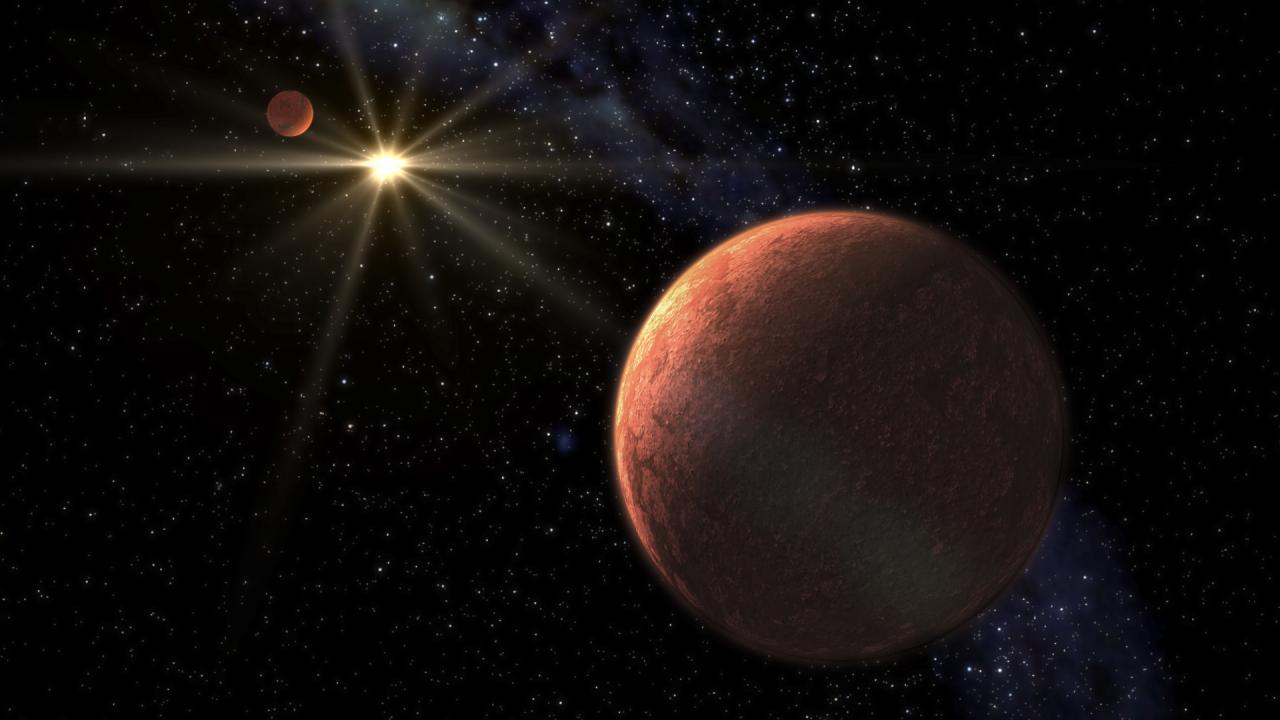General
Our goal is to study the processes that lead to the formation of low mass stars, brown dwarfs and planets and to characterize the physical properties of these objects in various evolutionary stages. Low mass stars and brown dwarfs are likely the most numerous type of objects in our Galaxy but due to their low intrinsic luminosity they are not so well known. We aim to study the frequency, multiplicity and spatial distribution of these objects in the solar neighbourhood and in nearby star forming regions and stellar clusters in order to better understand the mechanism of formation, characterise their optical and infrared properties and establish the relation between spectral properties, mass and luminosity.. Most of our effort will be dedicated to push toward lower mass limits the detection of these astros either bounded to stars and brown dwarfs and/or free-floating in interstellar space. The lowest mass objects display a lower intrinsic luminosity and cooler effective temperatures thus they are remarkably difficult to detect using direct imaging techniques. However, these techniques allow a full photometric and spectroscopic characterization and a best determination of their physical and chemical properties. We also aim to investigate the presence of planets around low mass stars using radial velocity measurements and techniques for high spatial resolution imaging. We will develop ultrastable spectrographs for large telescopes and systems for ultrafast imaging. With the spectrographs it would be possible to detect planets of similar mass to the Earth around G, K and M-type stars. The goal is to establish the frequency of these planets in stars of the solar neighbourhood and characterise the properties of the associated planetary systems.
Members
Results
- The optical and near-infrared sequence of 10 Myr-old L dwarfs in the nearest OB association to the Sun, Upper Scorpius
- The lithium depletion boundary of the Hyades cluster.
Scientific activity
Related publications
-
The extremely red L dwarf ULAS J222711-004547 - dominated by dust
We report the discovery of a peculiar L dwarf from the United Kingdom Infrared Deep Sky Survey Large Area Survey, ULAS J222711-004547. The very red infrared photometry (MKO J - K = 2.79 ± 0.06, WISE W1-W2 = 0.65 ± 0.05) of ULAS J222711-004547 makes it one of the reddest brown dwarfs discovered so far. We obtained a moderate resolution spectrum of
Marocco, F. et al.Advertised on:
32014 -
Binary frequency of planet-host stars at wide separations. A new brown dwarf companion to a planet-host star
Aims: The aim of the project is to improve our knowledge on the multiplicity of planet-host stars at wide physical separations. Methods: We cross-matched approximately 6200 square degree area of the southern sky imaged by the Visible Infrared Survey Telescope for Astronomy (VISTA) Hemisphere Survey (VHS) with the Two Micron All Sky Survey (2MASS)
Lodieu, N. et al.Advertised on:
92014 -
Discovery of a new Y dwarf: WISE J030449.03-270508.3
We present a new Y dwarf, WISE J030449.03-270508.3, confirmed from a candidate sample designed to pick out low-temperature objects from the Wide-field Infrared Survey Explorer (WISE) data base. The new object is typed Y0pec following a visual comparison with spectral standards, and lies at a likely distance of 10-17 pc. Its tangential velocity
Pinfield, D. J. et al.Advertised on:
102014 -
Trigonometric parallaxes of young field L dwarfs
Aims: We aim to determine the trigonometric parallaxes and proper motions of a sample of ten field L0-L5 dwarfs with spectroscopic evidence for low-gravity atmospheres. The ten sources were located in color-absolute magnitude diagrams and in the Hertzsprung-Russell (HR) diagram for age and mass derivations and were compared with field and star
Zapatero Osorio, M. R. et al.Advertised on:
82014 -
Search for free-floating planetary-mass objects in the Pleiades
Aims: We aim at identifying the least massive population of the solar metallicity, young (120 Myr), nearby (133.5 pc) Pleiades star cluster with the ultimate goal of understanding the physical properties of intermediate-age, free-floating, low-mass brown dwarfs and giant planetary-mass objects, and deriving the cluster substellar mass function
Zapatero Osorio, M. R. et al.Advertised on:
82014 -
The GAPS programme with HARPS-N at TNG. IV. A planetary system around XO-2S
We performed an intensive radial velocity monitoring of XO-2S, the wide companion of the transiting planet-host XO-2N, using HARPS-N at TNG in the framework of the GAPS programme. The radial velocity measurements indicate the presence of a new planetary system formed by a planet that is slightly more massive than Jupiter at 0.48 au and a Saturn
Borsa, F. et al.Advertised on:
72014 -
2MASS J154043.42-510135.7: a new addition to the 5 pc population
Aims: The aim of the project is to find the stars closest to the Sun and to contribute to the completion of the stellar and substellar census of the solar neighbourhood. Methods: We identified a new late-M dwarf within 5 pc, looking for high proper motion sources in the 2MASS-WISE cross-match. We collected astrometric and photometric data available
Pérez Garrido, A. et al.Advertised on:
72014 -
White Dwarfs in the UKIRT Infrared Deep Sky Survey Data Release 9
We have identified 8 to 10 new cool white dwarfs from the Large Area Survey (LAS) Data Release 9 of the United Kingdom InfraRed Telescope (UKIRT) Infrared Deep Sky Survey (UKIDSS). The data set was paired with the Sloan Digital Sky Survey to obtain proper motions and a broad ugrizYJHK wavelength coverage. Optical spectroscopic observations were
Tremblay, P.-E. et al.Advertised on:
62014 -
WTS-2 b: a hot Jupiter orbiting near its tidal destruction radius around a K dwarf
We report the discovery of WTS-2 b, an unusually close-in 1.02-d hot Jupiter (MP = 1.12MJ, RP = 1.30RJ) orbiting a K2V star, which has a possible gravitationally bound M-dwarf companion at 0.6 arcsec separation contributing ˜20 per cent of the total flux in the observed J-band light curve. The planet is only 1.5 times the separation from its host
Birkby, J. L. et al.Advertised on:
32014 -
Component masses of young, wide, non-magnetic white dwarf binaries in the Sloan Digital Sky Survey Data Release 7
We present a spectroscopic component analysis of 18 candidate young, wide, non-magnetic, double-degenerate binaries identified from a search of the Sloan Digital Sky Survey Data Release 7 (DR7). All but two pairings are likely to be physical systems. We show SDSS J084952.47+471247.7 + SDSS J084952.87+471249.4 to be a wide DA + DB binary, only the
Baxter, R. B. et al.Advertised on:
42014 -
The GAPS Programme with HARPS-N at TNG. III: The retrograde orbit of HAT-P-18b
The measurement of the Rossiter-McLaughlin effect for transiting exoplanets places constraints on the orientation of the orbital axis with respect to the stellar spin axis, which can shed light on the mechanisms shaping the orbital configuration of planetary systems. Here we present the interesting case of the Saturn-mass planet HAT-P-18b, which
Esposito, M. et al.Advertised on:
42014 -
New constraints on the formation and settling of dust in the atmospheres of young M and L dwarfs
Context. Gravity modifies the spectral features of young brown dwarfs (BDs). A proper characterization of these objects is crucial for the identification of the least massive and latest-type objects in star-forming regions, and to explain the origin(s) of the peculiar spectrophotometric properties of young directly imaged extrasolar planets and BD
Manjavacas, E. et al.Advertised on:
42014 -
The Tenth Data Release of the Sloan Digital Sky Survey: First Spectroscopic Data from the SDSS-III Apache Point Observatory Galactic Evolution Experiment
The Sloan Digital Sky Survey (SDSS) has been in operation since 2000 April. This paper presents the Tenth Public Data Release (DR10) from its current incarnation, SDSS-III. This data release includes the first spectroscopic data from the Apache Point Observatory Galaxy Evolution Experiment (APOGEE), along with spectroscopic data from the Baryon
Anders, Friedrich et al.Advertised on:
42014 -
ESPRESSO: The next European exoplanet hunter
The acronym ESPRESSO stems for Echelle SPectrograph for Rocky Exoplanets and Stable Spectroscopic Observations; this instrument will be the next VLT high resolution spectrograph. The spectrograph will be installed at the Combined-Coudé Laboratory of the VLT and linked to the four 8.2 m Unit Telescopes (UT) through four optical Coudé trains
Santos, N. C. et al.Advertised on:
12014 -
A frequency comb calibrated solar atlas
Context. The solar spectrum is a primary reference for the study of physical processes in stars and their variation during activity cycles. High resolution spectra of the Sun are easily obtained from spatially selected regions of the solar disk, while those taken over the integrated disk are more problematic. However, a proxy can be obtained by
Udem, Th. et al.Advertised on:
122013 -
A deep WISE search for very late type objects and the discovery of two halo/thick-disc T dwarfs: WISE 0013+0634 and WISE 0833+0052
A method is defined for identifying late-T and Y dwarfs in WISE down to low values of signal-to-noise. This requires a WISE detection only in the W2-band and uses the statistical properties of the WISE multiframe measurements and profile fit photometry to reject contamination resulting from non-point-like objects, variables and moving sources. To
Lucas, P. W. et al.Advertised on:
12014 -
Probing the Upper Scorpius mass function in the planetary-mass regime
We present the results of a deep ZYJ near-infrared survey of 13.5 deg2 in the Upper Scorpius (USco) OB association. We photometrically selected ˜100 cluster member candidates with masses in the range of 30-5 Jupiters, according to state-of-the-art evolutionary models. We identified 67 ZYJ candidates as bona fide members, based on complementary
Lodieu, N. et al.Advertised on:
112013 -
Very Low Mass Stellar and Substellar Companions to Solar-like Stars from MARVELS. IV. A Candidate Brown Dwarf or Low-mass Stellar Companion to HIP 67526
We report the discovery of a candidate brown dwarf (BD) or a very low mass stellar companion (MARVELS-5b) to the star HIP 67526 from the Multi-object Apache point observatory Radial Velocity Exoplanet Large-area Survey (MARVELS). The radial velocity curve for this object contains 31 epochs spread over 2.5 yr. Our Keplerian fit, using a Markov Chain
Jiang, P. et al.Advertised on:
92013 -
The first spectroscopically identified L dwarf in Praesepe
We have obtained a low-resolution optical spectrum for one of the faintest cluster member candidates in Praesepe with the Optical System for Imaging and low Resolution Integrated Spectroscopy mounted on the 10.4 m Gran Telescopio de Canarias. We confirm spectroscopically the first L dwarf member in Praesepe, UGCS J084510.66+214817.1. We derived an
Boudreault, S. et al.Advertised on:
92013 -
76 T dwarfs from the UKIDSS LAS: benchmarks, kinematics and an updated space density
We report the discovery of 76 new T dwarfs from the UKIRT Infrared Deep Sky Survey (UKIDSS) Large Area Survey (LAS). Near-infrared broad- and narrow-band photometry and spectroscopy are presented for the new objects, along with Wide-field Infrared Survey Explorer (WISE) and warm-Spitzer photometry. Proper motions for 128 UKIDSS T dwarfs are
Burningham, Ben et al.Advertised on:
72013



